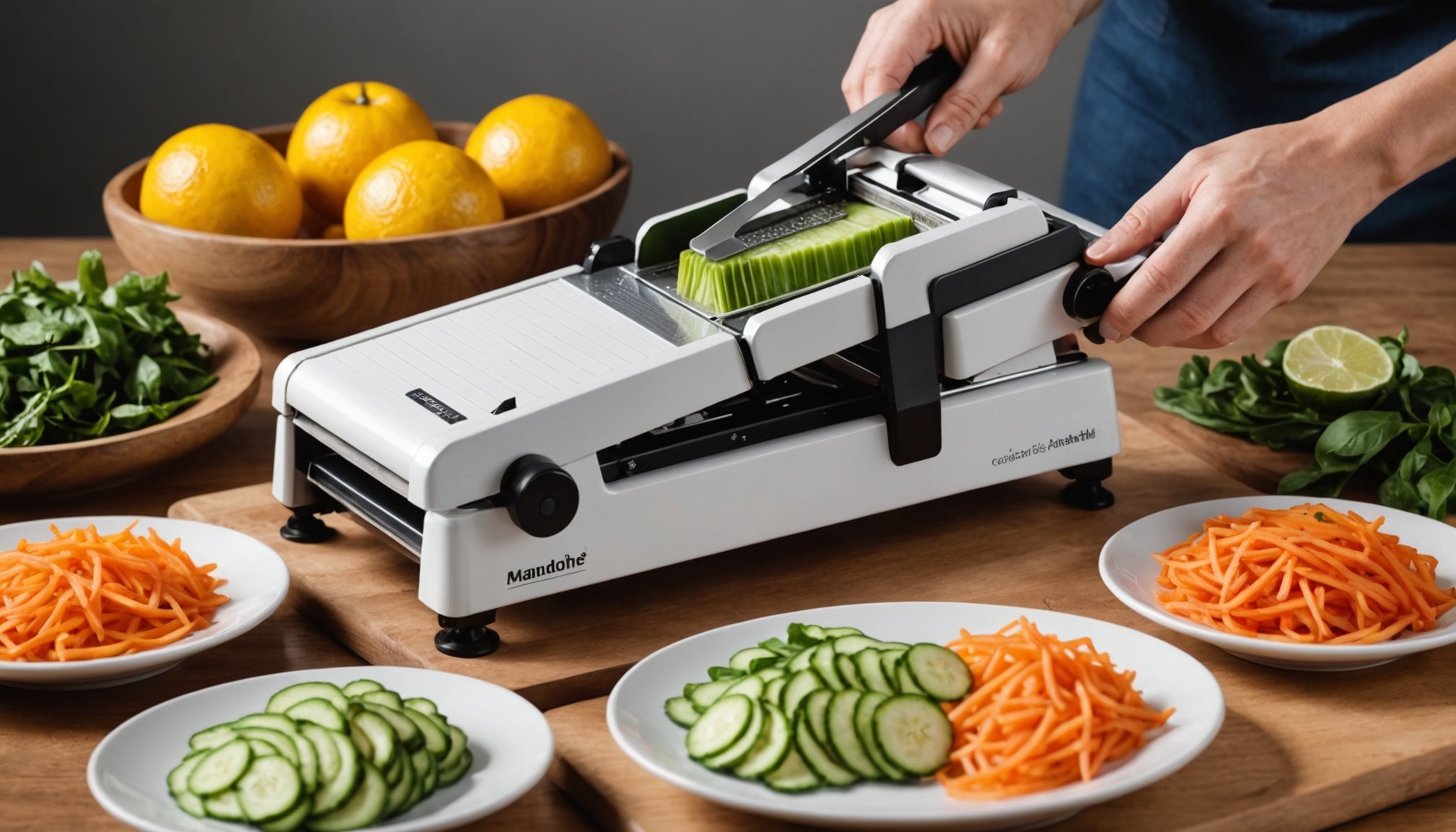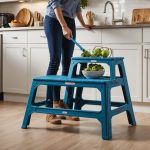Understanding Mandoline Slicers
A mandoline slicer is a versatile kitchen tool essential for achieving uniform cuts. Whether you are prepping vegetables or fruits, its precision helps enhance the visual appeal and cook of your dishes.
Types of mandoline slicers can generally be classified into two categories: manual and electric. Manual mandoline slicers demand user control to adjust the slicing pressure, which often allows for greater variety in cutting styles. They are also appreciated for their compact size and accessibility. On the other hand, electric mandoline slicers offer speed and consistency, ideal for large-scale food preparation. Their automated design minimizes effort, which can be particularly beneficial for those with limited dexterity.
There are several benefits of using a mandoline slicer. Firstly, speed and efficiency are paramount subjects; it can slice through ingredients swiftly without compromising precision. This tool not only saves time but also reduces food waste by ensuring all pieces are uniformly cut. Additionally, mandoline slicers enhance presentation, as uniform food dimensions contribute to dishes’ aesthetics, markedly during culinary plating. Such advantages significantly elevate the cooking experience, making mandoline slicers a valuable asset in both home kitchens and professional settings.
Key Features to Consider
When selecting a mandoline slicer, consider several essential features that can elevate your slicing experience. Adjustable slicing thickness is significant, granting flexibility to produce anything from ultra-thin slices to thicker cuts. Various blade types, such as straight, julienne, or crinkle-cut, add versatility to your culinary creations.
This might interest you : Effortlessly chop garlic without the mess: the ultimate guide to choosing your ideal uniform-style chopper
Build quality is another critical aspect. Opt for slicers made from durable materials, like stainless steel, which ensure longevity and provide consistent performance. The robustness of the design contributes to stability during use, enhancing both safety and efficiency.
Ease of cleaning and storage cannot be overlooked. Ideally, the mandoline slicer should have a user-friendly assembly and dismantling process to facilitate thorough cleaning. Some models even offer dishwasher-safe parts, simplifying maintenance.
For storage, look for a compact design with retractable blades or foldable stands. These features are especially beneficial in smaller kitchens where maximizing space is crucial. Features should align with your everyday cooking needs, ensuring the mandoline slicer becomes an integral and accessible tool in your kitchen. Prioritising these factors will lead to a more seamless culinary experience.
Brand Comparisons
When evaluating top mandoline slicer brands, it’s vital to consider reliable manufacturers and user ratings to ensure quality and satisfaction. Let’s explore the options available:
High-End Brands
High-end mandoline slicers often feature robust materials, versatile blade options, and ergonomic designs. These brands prioritize precision and ease of use, providing advanced features like dial-adjustable slicing thickness and multiple cutting blades. While pricier, their durability and enhanced functionality can justify the investment for serious culinary enthusiasts.
Mid-Range Options
Mid-range slicers strike a balance between cost and functionality. They offer adequate build quality and standard slicing capabilities suitable for everyday cooking tasks. While they may lack some premium features, they often come from reliable manufacturers and have positive user ratings for their ease of use and versatility.
Budget-Friendly Choices
For those prioritizing affordability, budget-friendly slicers offer basic slicing functions. Though often constructed with less durable materials, they still provide essential features like adjustable slicing thickness. Understanding user feedback helps identify those with good performance to ensure value for money without compromising on essential functionalities.
User Reviews and Experiences
Understanding the perspectives of those who use mandoline slicers can be invaluable. Customer feedback highlights the practical benefits and frustrations of these kitchen tools, offering real-world insights. Users often praise high-end brands for their superior build quality and smooth operation, noting that these slicers feel sturdier and perform efficiently. Testimonials frequently mention the ease of use, particularly with slicers offering adjustable slicing options, which users find ideal for diverse culinary projects.
However, common complaints arise with models that lack stable bases or have complex assembly, underscoring the importance of considering ergonomics and usability. Some user testimonials emphasise the convenience of dishwasher-safe parts, which simplify the cleaning process and contribute to more frequent use. Real-life examples show diverse applications, from crafting fine salads to preparing large quantities for meal prep, illustrating the slicer’s versatility.
In summary, reviewing user experiences offers a practical understanding of the advantages and limitations across different brands and price ranges. This can guide potential buyers towards more informed choices, aligning expectations with the functionalities they value in their cooking activities.
Safety Tips for Using Mandoline Slicers
Safety is paramount when using a mandoline slicer due to its sharp blades and precision cutting. Adopting proper cutting techniques can minimize risks and improve user confidence. Ensure to use protective gloves specifically designed for handling sharp tools. These gloves provide a layer of protection against accidental nicks.
Utilize the safety guard that accompanies most mandoline slicers. This attachment is essential for shielding fingers and maintaining steadiness while slicing. Remember, maintaining control over both the slicer and the ingredient is crucial. Use steady, consistent movements rather than applying excessive force, which can lead to slips.
Familiarise yourself with the slicer’s features before commencing use. Understanding how all components work together will aid in a safe experience. Additionally, always position the mandoline slicer on a stable surface to prevent slipping. This stability is vital as even minor movements can result in uneven cuts or accidents.
Injury prevention starts with awareness and cautious practices. Regularly inspect your slicer for any loose parts or dull blades, addressing these issues promptly to ensure optimal and safe performance. Maintaining respect for the tool’s sharpness is key to enjoying both its utility and longevity.
Maintenance and Care
Proper care for your mandoline slicer ensures its lasting functionality and safety. Effective maintenance starts with consistent cleaning. Thoroughly wash your slicer immediately after use to prevent residue build-up, which can dull the blades. If your slicer is made of stainless steel, mild dish soap and warm water are ideal. For models with dishwasher-safe parts, confirm compatibility to avoid potential damage.
Maintaining blade sharpness is crucial. Using a blade sharpener specifically designed for kitchen tools can help retain the slicer’s efficiency. Be attentive to signs of wear, as dull blades demand more force, increasing the risk of accidents. Regularly inspect for any loose fittings or parts that might need tightening.
Proper storage also contributes to prolonging your mandoline slicer’s lifespan. Store in a dry environment to prevent corrosion. For manual slicers with retractable blades, ensure these are secured inward to avoid accidental contact. Consider using blade covers or protective casings where available, reducing the risk of damage or injury.
By adhering to these care practices, you not only enhance the mandoline slicer’s durability but also ensure a safer food preparation process.
Popular Slicing Techniques
Exploring slicing techniques with a mandoline slicer can greatly enhance your culinary repertoire. Mastery of these techniques allows for precision and creativity in the kitchen, transforming ordinary meals into visual and taste delights.
Basic Slicing Techniques
Basic slicing methods such as julienne and waffle cuts form the foundation of many recipes. Julienne slices—thin, matchstick-style cuts—are perfect for salads and garnishes, offering a sophisticated texture. Waffle cuts, with their unique pattern, add visual appeal and crispness to dishes, particularly when frying potatoes or vegetables. These simple techniques can elevate mundane ingredients into culinary statements.
Advanced Slicing Techniques
For those looking to achieve professional results, advanced slicing techniques such as brunoise and chiffonade offer finely detailed cuts ideal for integrating delicate flavours. Brunoise, a tiny dice, is perfect for incorporating into sauces or soups, while chiffonade involves rolling leafy greens into thin ribbons, adding elegance to salads or garnishes. These techniques require practice but can impress in presentation and flavour integration.
Creative Uses in Cooking
Creative slicing applications enchant the dining experience. Try spiralling vegetables for salad presentations or creating thin fruit slices as dessert toppings. Using the mandoline slicer to its full potential cultivates innovation, ensuring each dish is both aesthetically pleasing and flavourful.
Visuals and Demonstrations
Utilising instructional videos is an essential part of mastering the mandoline slicer. These visual aids help you grasp the usage nuances that text descriptions might miss. Not only do they showcase the different types of mandoline slicers available, but they also illustrate a range of slicing techniques and offer a platform for learning safe handling practices. Watching experts demonstrate slicing adjustable options provides a deeper understanding of achieving different slice thicknesses and utilising blade types effectively.
Visual learning offers an engaging approach by breaking down complex tasks into actionable steps. For example, observing detailed mandoline slicer demonstrations can guide you on maintaining consistent pressure and using safety features, improving both the quality of cuts and reducing injury risk. Many reliable sources offer watchable content, with renowned culinary experts providing credible advice on adjusting and cleaning your device safely.
Choosing the right video resources is crucial. Platforms offering expert tutorials often accompany them with tips on mandoline slicer maintenance, ensuring viewers can prolong the device’s lifespan. By leveraging these resources, you can confidently and skillfully incorporate the mandoline slicer into your culinary activities.










